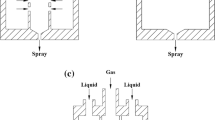Abstract
Two-phase flow was simulated within the effervescent atomizer by the volume of fluid interface tracing model. Different gas-to-liquid mass ratios (GLRs) of 0.08, 0.32, 1.24 and 4.9% at 0.38 L min−1 liquid flow rate have been studied. The purpose of this simulation is to study two-phase flow regimes within the effervescent atomizer and their effects on the atomization quality. The compressibility effect of the gas phase was considered in the present study, whereas it was ignored in the previous works. However, in this paper, the compressibility of gas phase has been included in the governing equations for GLR values of 1.24 and 4.9%, due to the high gas velocity. The effect of the gravity has also been considered through the all-numerical simulations. The results indicate that by increasing the GLR value, the two-phase bubbly flow with the type of Taylor bubbles transfers to the annular flow behavior at the inside of the discharge passage. In addition, the effect of the mixing chamber length on the thickness of the liquid film exiting from the effervescent atomizer investigated at different values of GLR. The simulation results showed that the effect of the mixing chamber length on the exiting liquid film thickness from the effervescent atomizer depends on GLR. At low GLR value (0.08%), increase in the mixing chamber length causes the liquid film thickness to increase. However, at high GLR value (1.24%) the behavior is vice versa. For middle value of GLR (0.32%), the liquid film thickness initially increases and then decreases as the mixing chamber length increases.













Similar content being viewed by others
References
Tricou C, Knasiak K. Development of a high transfer efficiency painting technology using effervescent atomization. In: ILASS-Americas 18th annual conference on liquid atomization and spray systems. Irvine; 2005.
Petersen FJ, Wørts O, Schæfer T, Sojka PE. Design and atomization properties for an inside-out type effervescent atomizer. Drug Dev Ind Pharm. 2004;30(3):319–26.
Petersen FJ, Wørts O, Schæfer T, Sojka PE. Effervescent atomization of aqueous polymer solutions and dispersions. Pharm Dev Technol. 2001;6(2):201–10.
Marshall SH. Air bubble formation from an orifice with liquid cross-flow. PhD Thesis, University of Sydney, Australia, 1992.
Lefebvre AH, Wang XF, Martin CA. Spray characteristics of aerated-liquid pressure atomizers. J Propul Power. 1988;4(4):293–8.
Lefebvre AH. A novel method of atomization with potential gas turbine applications. Def Sci J. 2014;38(4):353–62.
Roesler TC, Lefebvre AH. Studies on aerated-liquid atomization. Int J Turbo Jet Eng. 1989;6(3–4):221–30.
Sovani SD, Sojka PE, Lefebvre AH. Effervescent atomization. Prog Energy Combust Sci. 2001;27(4):483–521.
Zaremba M, Kozák J, Malý M, Weiß L, Rudolf P, Jedelský J, Jícha M. An experimental analysis of the spraying processes in improved design of effervescent atomizer. Int J Multiph Flow. 2018;103:1–5.
Ferreira ME, Martins JJ, Teixeira JC. Optimization of an effervescent atomizer to the combustion of residue oils. In: ASME 2005 summer heat transfer conference collocated with the ASME 2005 Pacific Rim technical conference and exhibition on integration and packaging of MEMS, NEMS, and electronic systems. American Society of Mechanical Engineers; 2005. p. 751–7.
Lin KC, Kennedy P, Jackson T. Structures of internal flow and the corresponding spray for aerated-liquid injectors. In: 37th Joint propulsion conference and exhibit; 2001. p. 3569.
Sarkar UK, Ramamurthi K. Flow visualization of sprays formed by bubbly, slug, and annular flows in an effervescent atomizer. J Flow Vis Image Process. 2007;14(4):397–408.
Qian L, Lin J. Modeling on effervescent atomization: a review. Sci China Phys Mech Astron. 2011;54(12):2109–29.
Tian M, Edwards J, Lin KC, Jackson T. Numerical simulation of transient two-phase flow with aerated liquid injectors. Part 2: flow structure. In: 33rd AIAA fluid dynamics conference and exhibit. p. 4266.
Esfarjani SA, Dolatabadi A. A 3D simulation of two-phase flow in an effervescent atomizer for suspension plasma spray. Surf Coat Technol. 2009;203(15):2074–80.
Mehmood K, Masud J. Analysis of two-phase flow in an effervescent atomizer using volume of fluid method. In: 50th AIAA aerospace sciences meeting including the new horizons forum and aerospace exposition; 2012. p. 312.
Helmy A, Wilson S, Siam A, Balabel A. Numerical modelling of two-phase flow in an effervescent atomizer using volume of fluid method. Int J Mod Phys Appl. 2015;1(4):186–92.
Jedelsky J, Jicha M, Slama J, Otahal J. Development of an effervescent atomizer for industrial burners. Energy Fuels. 2009;23(12):6121–30.
Mostafa A, Fouad M, Enayet M, Osman S. Measurements of spray characteristics produced by effervescent atomizers. In: 40th AIAA/ASME/SAE/ASEE joint propulsion conference and exhibit; 2004. p. 3378.
Liu M, Duan Y, Zhang T. Evaluation of effervescent atomizer internal design on the spray unsteadiness using a phase/Doppler particle analyzer. Exp Therm Fluid Sci. 2010;34(6):657–65.
Liu M, Duan Y, Zhang T, Xu Y. Evaluation of unsteadiness in effervescent sprays by analysis of droplet arrival statistics–the influence of fluids properties and atomizer internal design. Exp Therm Fluid Sci. 2011;35(1):190–8.
Jedelsky J, Landsmann M, Jicha M, Kuritka I. Effervescent atomizer: influence of the operation conditions and internal geometry on spray structure; study using PIV-PLIF. In: Proceedings of the 22th ILASS; 2008. p. 1–8.
Sher E, Koren M, Katoshewski D, Kholmer V. Energy consideration and experimental study of effervescent atomizers. In: Proceedings of the ILASS-Europe; 2000. Paper II. 7.
Hassanzadeh Jobehdar M., Siddiqui K. Experimental study of two-phase flow in a liquid cross-flow and an effervescent atomizer. PhD Thesis, University of Western Ontario, Canada. 2014.
Brackbill JU, Kothe DB, Zemach C. A continuum method for modeling surface tension. J Comput Phys. 1992;100(2):335–54.
Author information
Authors and Affiliations
Corresponding author
Electronic supplementary material
Below is the link to the electronic supplementary material.
Rights and permissions
About this article
Cite this article
Alizadeh Kaklar, Z., Ansari, M.R. Numerical analysis of the internal flow and the mixing chamber length effects on the liquid film thickness exiting from the effervescent atomizer. J Therm Anal Calorim 135, 1881–1890 (2019). https://doi.org/10.1007/s10973-018-7485-3
Received:
Accepted:
Published:
Issue Date:
DOI: https://doi.org/10.1007/s10973-018-7485-3




